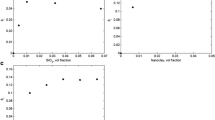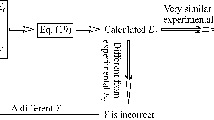Abstract
In this article, several models are applied to reveal the effects of volume fraction, thickness, strength and modulus of interphase region between polymer matrix and nanofiller on the Young’s modulus and yield strength of polymer nanocomposites. The properties of interphase are calculated for several samples by experimental data of mechanical properties. It is found that the concentration of interphase is higher than that of nanofiller in some samples. The Young’s modulus of nanocomposites largely depends on filler and interphase concentrations. In addition, the highest fraction and strength of interphase region produce the highest yield strength of nanocomposites.




Similar content being viewed by others
REFERENCES
Zare, Y. and Rhee, K.Y., Evaluation and Development of Expanded Equations Based on Takayanagi Model for Tensile Modulus of Polymer Nanocomposites Assuming the Formation of Percolating Networks, Phys. Mesomech., 2018, vol. 21, no. 4, pp. 351–357.
Panin, V.E., Surikova, N.S., Smirnova, A.S., and Pochivalov, Yu.I., Mesoscopic Structural States in Plastically Deformed Nanostructured Metal Materials, Phys. Mesomech., 2018, vol. 21, no. 5, pp. 396–400.https://doi.org/10.1134/S102995991805003X
Nikonov, A.Yu., Zharmukhambetova, A.M., Ponomareva, A.V., and Dmitriev, A.I., Numerical Study of Mechanical Properties of Nanoparticles of β-Type Ti-Nb Alloy under Conditions Identical to Laser Sintering. Multilevel Approach, Phys. Mesomech., 2018, vol. 21, no. 1, pp. 43–51.
Badamshina, E.R., Goldstein, R.V., Ustinov, K.B., and Estrin, Ya.I., Strength and Fracture Toughness of Polyurethane Elastomers Modified with Carbon Nanotubes, Phys. Mesomech., 2018, vol. 21, no. 3, pp. 187–192.
Mauroy, H., Plivelic, T.S., Suuronen, J.-P., Hage, F.S., Fossum, J.O., and Knudsen, K.D., Anisotropic Clay–Polystyrene Nanocomposites: Synthesis, Characterization and Mechanical Properties, Appl. Clay Sci., vol. 108, pp. 19–27.
Boumbimba, R.M., Wang, K., Bahlouli, N., Ahzi, S., Rémond, Y., and Addiego, F., Experimental Investigation and Micromechanical Modeling of High Strain Rate Compressive Yield Stress of a Melt Mixing Polypropylene Organoclay Nanocomposites, Mech. Mater., 2012, vol. 52, pp. 58–68.
Miyagawa, H., Rich, M.J., and Drzal, L.T., Amine-Cured Epoxy/Clay Nanocomposites. II. The Effect of the Nanoclay Aspect Ratio, J. Polym. Sci. B. Polym. Phys., 2004, vol. 42, pp. 4391–4400.
Odegard, G., Clancy, T., and Gates, T., Modeling of the Mechanical Properties of Nanoparticle/Polymer Composites, Polymer, 2005, vol. 46, pp. 553–562.
Pontefisso, A., Zappalorto, M., and Quaresimin, M., An Efficient RVE Formulation for the Analysis of the Elastic Properties of Spherical Nanoparticle Reinforced Polymers, Comput. Mater. Sci., 2015, vol. 96, pp. 319–326.
Hassanzadeh-Aghdam, M.K., Ansari, R., and Mahmoodi, M.J., Thermo-Mechanical Properties of Shape Memory Polymer Nanocomposites Reinforced by Carbon Nanotubes, Mech. Mater., 2019, vol. 129, pp. 80–98.
Ishak, Z.M., Chow, W., and Takeichi, T., Compatibilizing Effect of SEBS-g-MA on the Mechanical Properties of Different Types of OMMT Filled Polyamide6/Polypropylene Nanocomposites, Compos. A. Appl. Sci. Manufact., 2008, vol. 39, pp. 1802–1814.
Zare, Y. and Rhee, K.Y., Tensile Strength Prediction of Carbon Nanotube Reinforced Composites by Expansion of Cross-Orthogonal Skeleton Structure, Compos. B. Eng., 2019, vol. 161, pp. 601–607.
Zare, Y. and Rhee, K.Y., Evaluation of the Tensile Strength in Carbon Nanotube-Reinforced Nanocomposites Using the Expanded Takayanagi Model, JOM, 2019, pp. 1–9.
Zare, Y., Modeling Approach for Tensile Strength of Interphase Layers in Polymer Nanocomposites, J. Coll. Int. Sci., 2016, vol. 471, pp. 89–93.
Lu, P., Leong, Y., Pallathadka, P., and He, C., Effective Moduli of Nanoparticle Reinforced Composites Considering Interphase Effect by Extended Double-Inclusion Model—Theory and Explicit Expressions, Int. J. Eng. Sci., 2013, vol. 73, pp. 33–55.
Zare, Y., Determination of Polymer–Nanoparticles Interfacial Adhesion and Its Role in Shape Memory Behavior of Shape Memory Polymer Nanocomposites, Int. J. Adhes. Adhesiv., 2014, vol. 54, pp. 67–71.
Ji, X.L., Jing, J.K., Jiang, W., and Jiang, B.Z., Tensile Modulus of Polymer Nanocomposites, Polymer Eng. Sci., 2002, vol. 42, pp. 983–993.
Pukanszky, B., Influence of Interface Interaction on the Ultimate Tensile Properties of Polymer Composites, Composites, 1990, vol. 21, pp. 255–262.
Szazdi, L., Pozsgay, A., and Pukanszky, B., Factors and Processes Influencing the Reinforcing Effect of Layered Silicates in Polymer Nanocomposites, Eur. Polymer J., 2007, vol. 43, pp. 345–359.
Dominkovics, Z., Hári, J., Kovács, J., Fekete, E., and Pukánszky, B., Estimation of Interphase Thickness and Properties in PP/Layered Silicate Nanocomposites, Eur. Polymer J., 2011, vol. 47, pp. 1765–1774.
Chang, Y.W., Kim, S., and Kyung, Y., Poly (Butylene Terephthalate)–Clay Nanocomposites Prepared by Melt Intercalation: Morphology and Thermomechanical Properties, Polymer Int., 2005, vol. 54, pp. 348–353.
Hu, Y., Shen, L., Yang, H., Wang, M., Liu, T., Liang, T., and Zhang, J., Nanoindentation Studies on Nylon 11/Clay Nanocomposites, Polym. Test, 2006, vol. 25, pp. 492–497.
Kontou, E. and Niaounakis, M., Thermo-Mechanical Properties of LLDPE/SiO2 Nanocomposites, Polymer, 2006, vol. 47, pp. 1267–1280.
Yeh, M.-K., Hsieh, T.-H., and Tai, N.-H., Fabrication and Mechanical Properties of Multi-Walled Carbon Nanotubes/Epoxy Nanocomposites, Mater. Sci. Eng. A, 2008, vol. 483, pp. 289–292.
Isayev, A., Kumar, R., and Lewis, T.M., Ultrasound Assisted Twin Screw Extrusion of Polymer–Nanocomposites Containing Carbon Nanotubes, Polymer, 2009, vol. 50, pp. 250–260.
Li, Y., Waas, A.M., and Arruda, E.M., The Effects of the Interphase and Strain Gradients on the Elasticity of Layer by Layer (LBL) Polymer/Clay Nanocomposites, Int. J. Solid. Struct., 2011, vol. 48, pp. 1044–1053.
Boutaleb, S., Zanri, F., Mesbah, A., Naпt-Abdelaziz, M., Gloaguen, J.-M., Boukharouba, T., and Lefebvre, J.-M., Micromechanics-Based Modelling of Stiffness and Yield Stress for Silica/Polymer Nanocomposites, Int. J. Solid. Struct., 2009, vol. 46, pp. 1716–1726.
Author information
Authors and Affiliations
Corresponding author
Additional information
Russian Text © The Author(s), 2019, published in Fizicheskaya Mezomekhanika, 2020, Vol. 23, No. 1, pp. 104–111.
Rights and permissions
About this article
Cite this article
Zare, Y., Rhee, KY. How Interphase Properties Control the Young’s Modulus and Yield Strength of Polymer Nanocomposites?. Phys Mesomech 23, 531–537 (2020). https://doi.org/10.1134/S1029959920060089
Received:
Revised:
Accepted:
Published:
Issue Date:
DOI: https://doi.org/10.1134/S1029959920060089




